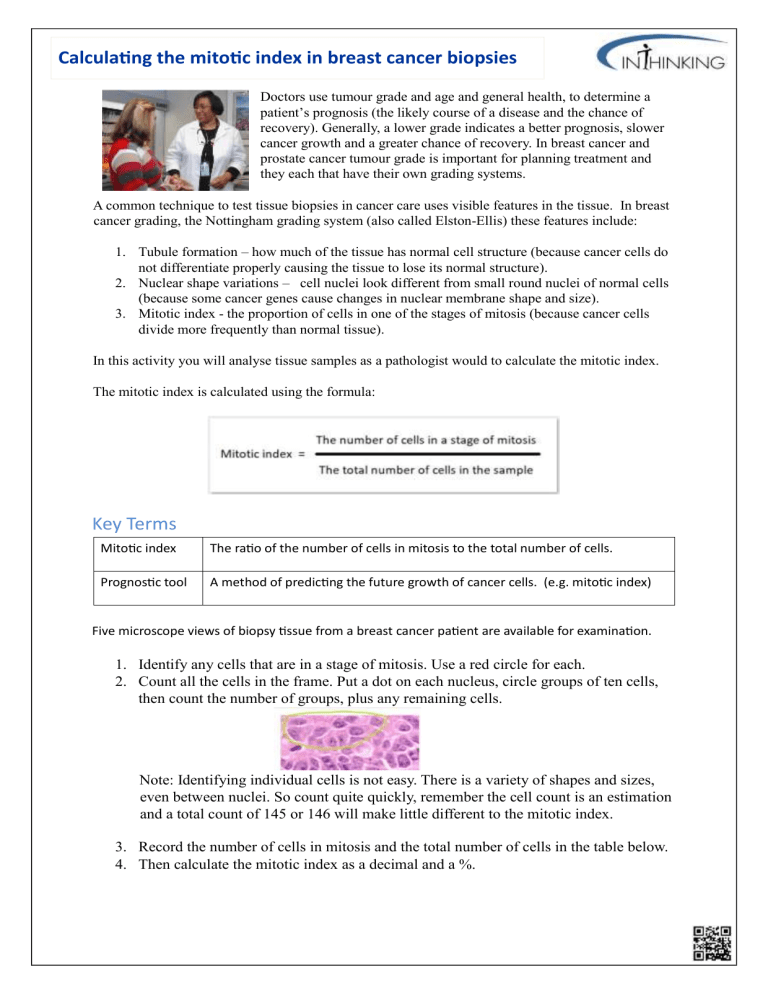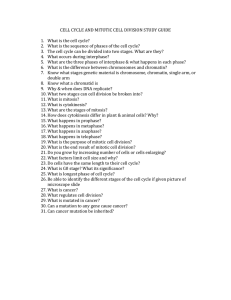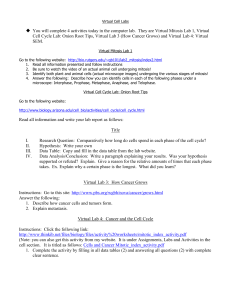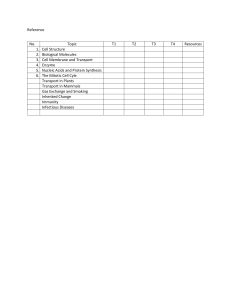Mitotic Index in Breast Cancer Biopsies Worksheet
advertisement

Calculating the mitotic index in breast cancer biopsies Doctors use tumour grade and age and general health, to determine a patient’s prognosis (the likely course of a disease and the chance of recovery). Generally, a lower grade indicates a better prognosis, slower cancer growth and a greater chance of recovery. In breast cancer and prostate cancer tumour grade is important for planning treatment and they each that have their own grading systems. A common technique to test tissue biopsies in cancer care uses visible features in the tissue. In breast cancer grading, the Nottingham grading system (also called Elston-Ellis) these features include: 1. Tubule formation – how much of the tissue has normal cell structure (because cancer cells do not differentiate properly causing the tissue to lose its normal structure). 2. Nuclear shape variations – cell nuclei look different from small round nuclei of normal cells (because some cancer genes cause changes in nuclear membrane shape and size). 3. Mitotic index - the proportion of cells in one of the stages of mitosis (because cancer cells divide more frequently than normal tissue). In this activity you will analyse tissue samples as a pathologist would to calculate the mitotic index. The mitotic index is calculated using the formula: Key Terms Mitotic index The ratio of the number of cells in mitosis to the total number of cells. Prognostic tool A method of predicting the future growth of cancer cells. (e.g. mitotic index) Five microscope views of biopsy tissue from a breast cancer patient are available for examination. 1. Identify any cells that are in a stage of mitosis. Use a red circle for each. 2. Count all the cells in the frame. Put a dot on each nucleus, circle groups of ten cells, then count the number of groups, plus any remaining cells. Note: Identifying individual cells is not easy. There is a variety of shapes and sizes, even between nuclei. So count quite quickly, remember the cell count is an estimation and a total count of 145 or 146 will make little different to the mitotic index. 3. Record the number of cells in mitosis and the total number of cells in the table below. 4. Then calculate the mitotic index as a decimal and a %. 1 © David Faure, InThinking http://www.thinkib.net/biology Sample 1 – From a patient called Jacintha who is 35 years old and in good general health. Microscope view A B C D E Total Number of cells doing mitosis 2 0 2 2 3 9 Total number of cells in the slide 30 30 36 29 21 146 Sample 2 – From a patient called Angela who is a slightly overweight 58 year old smoker. Microscope view F G H I J Total Number of cells doing mitosis 2 2 1 1 1 7 Total number of cells in the slide 30 37 34 20 24 145 Calculating mitotic index Tissue Type Patient 1 - Jacintha Total Number of cells Number of cells in any phase of mitosis 146 9 Mitotic index 0.062 Mitotic index expressed as a % 6.2% Patient 2 - Angela 145 7 0.048 4.8% 2 Analysis of data To convert a mitotic index expressed as a decimal, or a fraction, multiply this number by 100 to get the percentage of cells undergoing mitosis in your sample. Questions 1. What does your data show about mitotic index in each of the samples cancerous tissue? ………………………………………………………………………………………………………………………………………………. ………………………………………………………………………………………………………………………………………………. ………………………………………………………………………………………………………………………………………………. ………………………………………………………………………………………………………………………………………………. 2. Who’s cancer appears to be the fastest growing? Explain your answer, using mitotic index. ………………………………………………………………………………………………………………………………………………. ………………………………………………………………………………………………………………………………………………. ………………………………………………………………………………………………………………………………………………. ………………………………………………………………………………………………………………………………………………. 3. Compare the results to these examples, which show the three grades of breast tissue. Suggest advice that you might give to each these patients if you were their doctor. This could include, how aggressive the treatment would need to be, how serious the cancer is. ………………………………………………………………………………………………………………………………………………. ………………………………………………………………………………………………………………………………………………. ………………………………………………………………………………………………………………………………………………. ………………………………………………………………………………………………………………………………………………. ………………………………………………………………………………………………………………………………………………. ……………………………………………………………………………………………………………………………………………… 3




